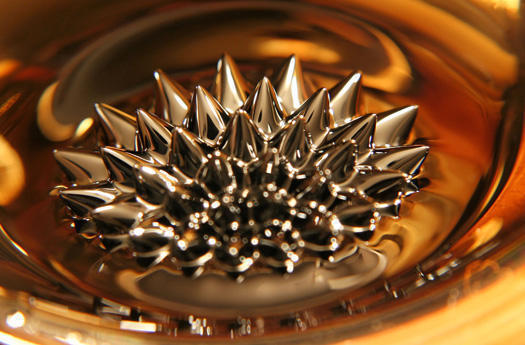What Are Ferrofluids?
A ferrofluid is a metallic liquid that becomes magnetized when placed in a magnetic field. Ferrofluids are made up of clumps of iron nanoparticles that are evenly placed throughout a carrier fluid such as water or organic solvent. These clumps all work together to create a response to a magnetic field, consequently creating a very strong magnetic bond. Ferrofluids should not be confused with magnetorheological fluids, which solidify when exposed to a magnetic field.
How a Ferrofluid Works
Ferrofluids are made up of clumps of nanoscale particles of a metal alloy and consist of iron, usually magnetite or hematite. Because these clumps are so small, they are prone to a natural phenomenon known as thermal agitation that causes the clumps to spread out throughout the carrier fluid. However, the clumps are still held together when in the presence of a magnetic field. Ferrofluids have both liquid and solid properties, as the metallic, nanosized clumps are solid while the carrier fluid is a liquid.
Applications
Ferrofluids have many uses. For example, ferrofluids can be used as a sealant that forms a barrier around the rotating shaft in an electronic hard drive in order to prevent debris from entering the interior compartment and damaging the hard drive. Ferrofluids can also be used to create a lubricant that causes a magnet to glide across a smooth surface, due to their friction-reducing effects. Most notably, ferrofluids are used in the medical field as cancer treatment. This is because ferrofluid nanoparticles (in the form of iron oxide) can enter cancer cells and release heat when exposed to an alternating magnetic field.
Advantages
Ferrofluids reflect light, reduce friction, and bond together on a nanoscale. They are made of many microscopic magnets, which make every drop susceptible to magnetic fields. Ferrofluids can withstand up to four PSI (Pounds per Square Inch) when under the effects of a magnetic field and can last for several years before deteriorating.
Disadvantages
In a stable ferrofluid, the clumps of nanoparticles do not stick together or spread too far apart. However, after a few years, the surfactant that covers each clump begins to break down and causes the clumps to begin fusing with each other. Likewise, the larger pieces cause the clumps to spread out and lose their magnetic properties. The clumps also lose their magnetic properties when exposed to a high enough temperature.


Comments - No Responses to “What Are Ferrofluids?”
Sorry but comments are closed at this time.